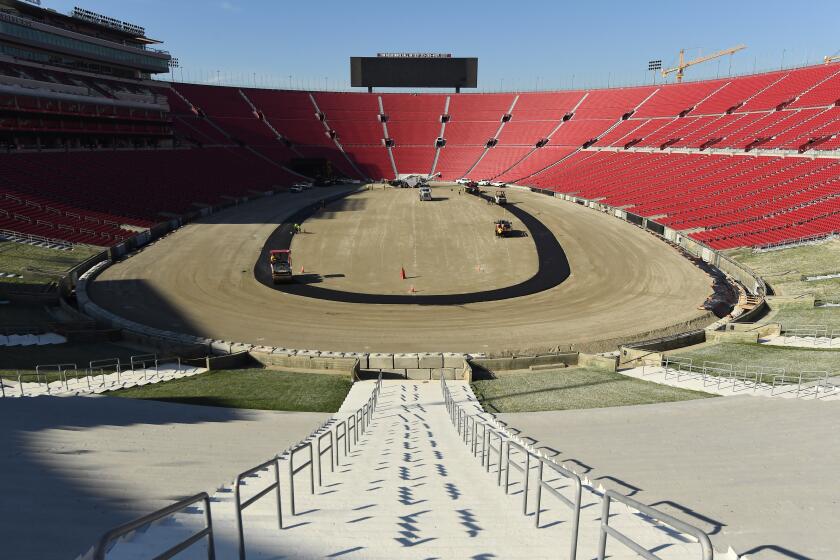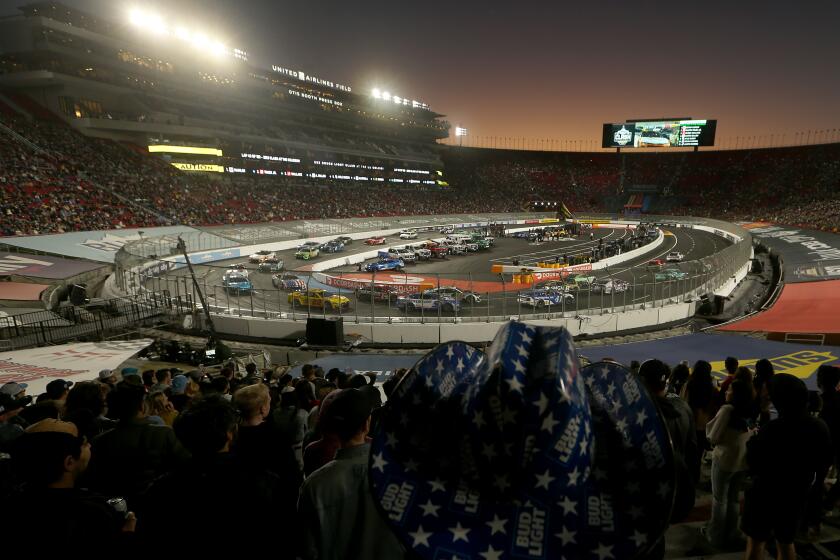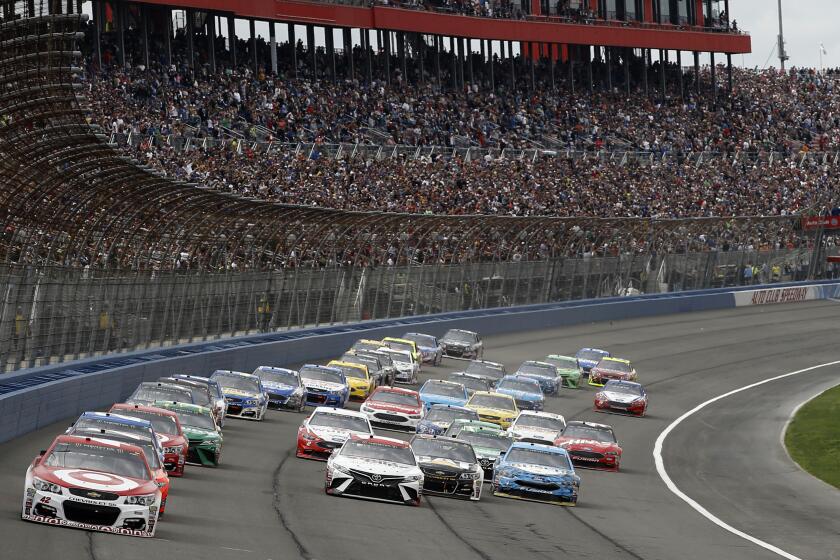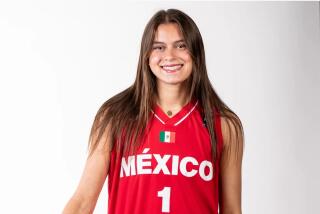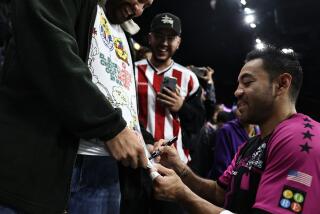NASCAR’s Mexico Series makes a stop at the L.A. Coliseum in first U.S. race since 2015
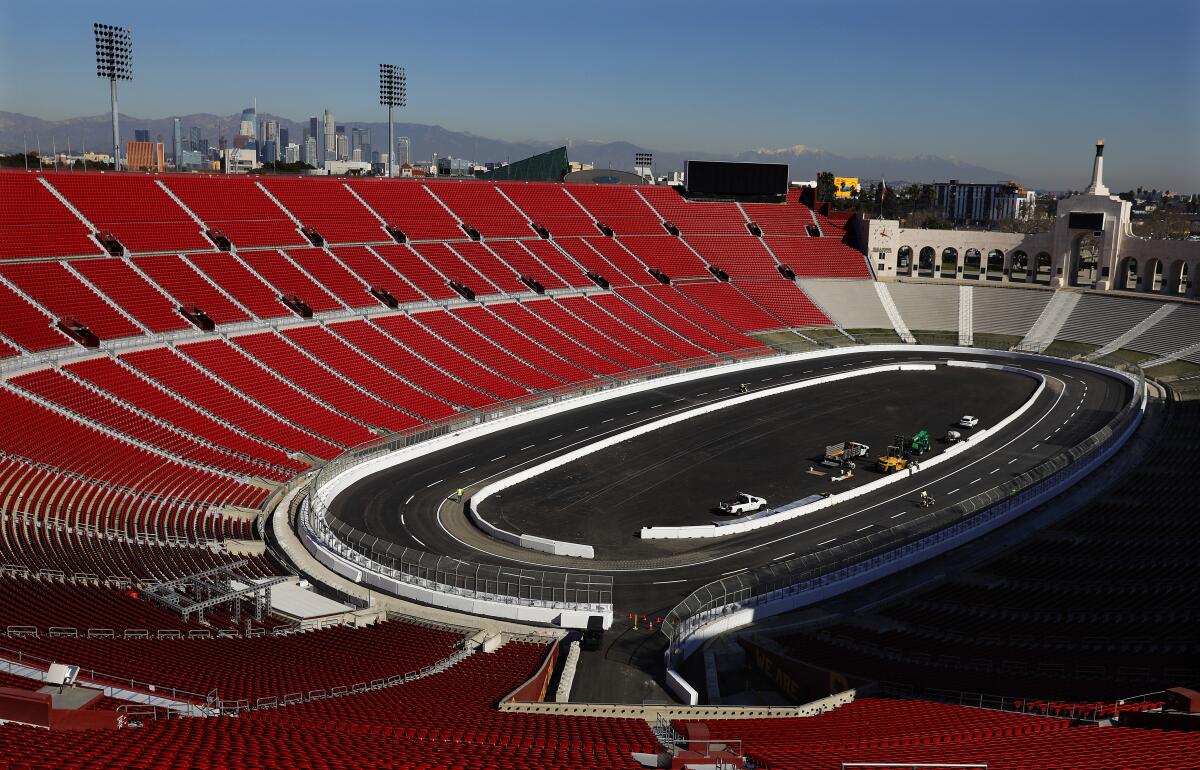
- Share via
There has never been any doubt that NASCAR’s inventive and seemingly crazy idea of building an auto racing track inside the L.A. Memorial Coliseum was a totally transparent attempt to increase its footprint in its largest market in the country. But now in the third year of its season kickoff event, NASCAR has shown its cards even more and its desire to work its way further into the Latino market.
The King Taco La Batalla en El Coliseo was scheduled to be the warmup to Sunday’s Busch Light Clash at the Coliseum, before bad weather forced NASCAR to move the races to Saturday, with the Clash running first. It was the first time the Mexico Series has raced in the United States since 2015 when it was in Phoenix.
“This was a no-brainer decision for us,” said Chad Seigler, chief international officer for NASCAR, about the decision to race in Los Angeles. “Besides just growing the sport, growing the Hispanic audience has been a key initiative for us. … Los Angeles has the second-largest Mexican Hispanic population base in North America outside of Mexico City. We knew the crossover appeal would be there so a lot of those things played in together.”
Photos of the transformation of the historical Los Angeles Memorial Coliseum from football stadium to a quarter-mile short track NASCAR racetrack.
The idea was talked about internally last year, but the logistics were too big of an obstacle. But the idea did not die.
“We started working early in the summer of last year and by August we were finally in a spot where we could start notifying all of our teams that we’re going to do this,” Seigler said.
Los Angeles is NASCAR’s largest market with just shy of 2 million fans. About 850,000 are Latino and more than 50% are considered multicultural. Among new fans, less than three years, 32% are Latino.
So, what is the NASCAR Mexico Series?
It was started in 2004 and this year it will have 12 races, all but one in Mexico. The circuit is a cut below the U.S. Cup and Xfinity Series with cars that have lower horsepower, less technology and, most importantly, less cost to run and operate.
“If you go into Mexico and talk about NASCAR, people will probably tell you who is the current Mexican champion,” Seigler said. “We try and create in-market stars and an infrastructure that includes team owners, mechanics and race track promoters. … The second part we try strategically to do, is if there is a driver that says their dream is not just to stay in Mexico but make it to the Cup Series, we try and provide a pathway to the Cup Series. Danny Suárez is a perfect example, he’s a driver that left the Mexico Series and went to the Xfinity series and now is in the Cup Series.”
NASCAR made the historic decision to move the Busch Light Clash and Mexico Series racing at the Coliseum from Sunday to today in order to avoid rain.
Suárez hoped to drive in both races but did not qualify for the Clash. He was ranked 19th last year in the Cup standings and was the first Mexican driver to win a Cup race when he was first in the Sonoma race in 2022.
“I can’t wait to see a lot of the people I used to race with,” Suárez said this week. “I never dreamed something like this would ever happen. I am very proud of the series. Without the Mexico Series I don’t think I would have ever had a chance of becoming a Cup Series driver. I am honored to be invited to race and see it as a way to say thank you for everything that series did for me over the years. Plus, I really want us to put on a good show.”
Martin Truex, Jr., who won last year’s Clash, is no stranger to racing in Mexico, having won the first NASCAR race there in 2005 in the Busch Series, now known as Xfinity. The promoter estimated the crowd at more than 94,000.
NASCAR teams have done what once seemed impossible, building a track inside L.A.’s Coliseum. This is how they did it and how drivers feel about it.
“It felt different being there,” Truex said. “It was really interesting. We stayed at a hotel [instead of a trailer] and bussed to the track. It had a totally different feel to it and you definitely felt far from home. … I remember it was just crazy and being a lot. I remember seeing everyone standing, and then after the race all the music playing and all the people partying in the stands. It was pretty wild. And then you saw people all around the track looking through the fences.”
Truex understands what Saturday’s race could mean to the Mexico Series.
“Obviously, this is a big stage for them to showcase their series and showcase their drivers,” he said. “With Suárez coming out of that and being a Cup driver [underscores that]. They are going to be on a big stage and it’s a great opportunity for drivers to get noticed. I’m sure a lot of them are trying to make their way in like Daniel did.”
Opportunity can sometimes need a little help, or the absence of obstacles. Getting the 22 cars into the country for Saturday’s practice took a little maneuvering.
Weather permitting, NASCAR will race on the 2-mile oval at Auto Club Speedway in Fontana for the final time Sunday before the track is shortened to a half-mile.
“A lot of the teams are based in Mexico City, several of the teams are based in Guadalajara, there are some teams based in the Monterrey region,” Seigler said. “You take Mexico City as the hub, where all the teams meet. It’s about a 35-hour trip from Mexico City to Tijuana. All of those car haulers form what I like to call a convoy and they make the trip in two days of driving just to get to the border.
“Once you get to the border there are some basic [Department of Transportation] restrictions. Certain haulers that you have in Mexico don’t meet those requirements so you have to swap those out to a truck that is capable of going into the U.S. You have to come to a meeting spot at the border, unhook all your trucks and trailers, bring in another truck to bring it in to the U.S. It’s not a problem but a challenge.”
There is also the issue of getting visas for the crews. Seigler said things have been very smooth.
NASCAR is hoping that the addition of the Mexico Series race will raise the sport’s profile in the important Los Angeles region. With the track in Fontana being torn down with no firm date for rebuilding, and this being the last year of a three-year deal with the Coliseum, a good show is vital to keeping live racing going in the region.
More to Read
Go beyond the scoreboard
Get the latest on L.A.'s teams in the daily Sports Report newsletter.
You may occasionally receive promotional content from the Los Angeles Times.
